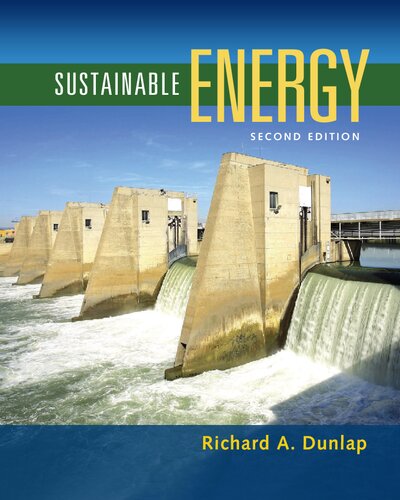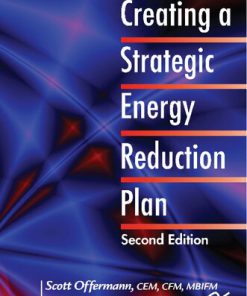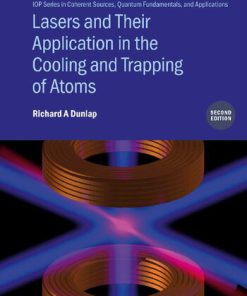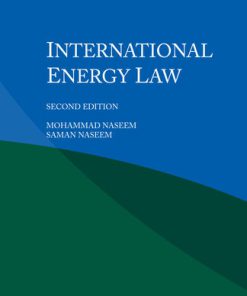Sustainable Energy, 2nd 2nd Edition by Richard A. Dunlap 9781337551663 133755166X
$50.00 Original price was: $50.00.$25.00Current price is: $25.00.
Sustainable Energy, 2nd 2nd Edition Richard A. Dunlap – Ebook Instant Download/Delivery ISBN(s): 9781337551663,133755166X

Product details:
- ISBN 10:133755166X
- ISBN 13: 9781337551663
- Author: Richard A. Dunlap
Sustainable Energy
Table contents:
Part I. Background
Chapter 1. Energy Basics
1.1. Introduction
1.2. Work, Energy, and Power
1.3. Forms of Energy
1.3a. Kinetic Energy
1.3b. Potential Energy
1.3c. Thermal Energy
1.3d. Chemical Energy
1.3e. Nuclear Energy
1.3f. Electrical Energy
1.3g. Electromagnetic Energy
1.4. Some Basic Thermodynamics
1.4a. The Zeroth Law of Thermodynamics
1.4b. The First Law of Thermodynamics
1.4c. The Second Law of Thermodynamics
1.4d. The Third Law of Thermodynamics
1.5. Heat Engines and Heat Pumps
1.6. Electricity Generation
1.6a. Thermal Electricity Generation
1.6b. Combustion Turbines
1.6c. Diesel Generators
1.6d. Distribution of Electricity
1.7. Summary
Problems
Bibliography
Chapter 2. Past, Present, and Future World Energy Use
2.1. Introduction
2.2. Past and Present Energy Use
2.3. Exponential Growth
2.4. The Hubbert Model of Resource Utilization
2.5. Challenges for Sustainable Energy Development
2.5a. Resource Limitations
2.5b. Technological Limitations
2.5c. Economic Factors
2.5d. Social Factors
2.5e. Environmental Factors
2.5f. Political Factors
2.5g. Integrating New Technology with Existing Infrastructure
2.6. Summary
Problems
Bibliography
Part II. Fossil Fuels
Chapter 3. Fossil Fuel Resources and Use
3.1. Introduction
3.2. Oil
3.3. Refining
3.4. Natural Gas
3.5. Coal
3.6. Overview of Fossil Fuel Resources
3.6a. Oil
3.6b. Natural Gas
3.6c. Coal
3.7. Enhanced Oil Recovery
3.8. Oil Shale
3.9. Extra-Heavy Oil and Tar Sands
3.10. Coal Liquefaction and Gasification
3.11. Summary
Problems
Bibliography
Chapter 4. Environmental Consequences of Fossil Fuel Use
4.1. Introduction
4.2. Thermal Pollution
4.3. Chemical and Particulate Matter Pollution
4.3a. Carbon Monoxide
4.3b. Nitrogen Oxides
4.3c. Hydrocarbons
4.3d. Sulfur Dioxide
4.3e. Particulate Matter
4.4. The Greenhouse Effect
4.5. Climate Change
4.6. Carbon Sequestration
4.7. International Climate Change Initiatives
4.7a. United Nations Framework Convention on Climate Change (UNFCCC)
4.7b. Kyoto Protocol
4.7c. Paris Accord
4.8. Summary
Problems
Bibliography
Part III. Nuclear Energy
Chapter 5. Some Basic Nuclear Physics
5.1. Introduction
5.2. The Structure of the Nucleus
5.3. Binding Energy
5.4. Nuclear Decays
5.5. Nuclear Reactions
5.6. Summary
Problems
Bibliography
Chapter 6. Energy from Nuclear Fission
6.1. Introduction
6.2. The Fission of Uranium
6.3. Nuclear Reactor Design
6.4. Fission Reactor Control
6.5. Types of Thermal Neutron Reactors
6.6. Current Use of Fission Energy
6.7. Uranium Resources
6.8. Nuclear Safety
6.8a. Three Mile Island
6.8b. Chernobyl
6.8c. Fukushima Dai-ichi
6.9. Risk Assessment
6.10. Waste Disposal
6.11. Advanced Reactor Design
6.12. Fast Breeder Reactors
6.13. Summary
Problems
Bibliography
Chapter 7. Energy from Nuclear Fusion
7.1. Introduction
7.2. Fusion Energy
7.3. Magnetic Confinement Reactors
7.4. Inertial Confinement Reactors
7.5. Progress Toward a Fusion Reactor
7.6. Summary
Problems
Bibliography
Part IV. Renewable Energy
Chapter 8. Direct Use of Solar Energy
8.1. Introduction
8.2. Properties of Sunlight
8.3. Heat Transfer
8.3a. Conduction
8.3b. Convection
8.3c. Radiation
8.4. Solar Collector Design
8.5. Residential Heating Needs
8.6. Heat Storage
8.7. Passive Solar Heating
8.8. Transpired Solar Collectors
8.9. Summary
Problems
Bibliography
Chapter 9. Electricity from Solar Energy
9.1. Introduction
9.2. Solar Electric Generation
9.2a. Parabolic Troughs
9.2b. Parabolic Dishes
9.2c. Central Receivers
9.2d. Solar Ponds
9.3. Photovoltaic Devices
9.4. Application of Photovoltaic Devices
9.5. Global Use of Photovoltaics
9.6. Summary
Problems
Bibliography
Chapter 10. Wind Energy
10.1. Introduction
10.2. Wind Turbine Design
10.3. Obtaining Energy from the Wind
10.4. Applications of Wind Power
10.5. Summary
Problems
Bibliography
Chapter 11. Hydroelectric Energy
11.1. Introduction
11.2. Energy from Water
11.3. Turbine Design
11.4. High Head Systems
11.5. Low Head and Run-of-the-River Systems
11.6. Utilization of Hydroelectric Power
11.7. Environmental Consequences of Hydroelectric Energy
11.8. Summary
Problems
Bibliography
Chapter 12. Wave Energy
12.1. Introduction
12.2. Energy from Waves
12.3. Wave Power Devices
12.3a. Oscillating Water Columns (OWCs)
12.3b. Floats and Pitching Devices
12.3c. Wave-Focusing Devices
12.4. Wave Energy Resources
12.5. Summary
Problems
Bibliography
Chapter 13. Tidal Energy
13.1. Introduction
13.2. Energy from the Tides
13.3. Barrage Systems
13.4. Nonbarrage Tidal Power Systems
13.4a. Tidal Lagoons
13.4b. Underwater Turbines
13.4c. Tidal Fences
13.5. Summary
Problems
Bibliography
Chapter 14. Ocean Thermal Energy Conversion and Ocean Salinity Gradient Energy
14.1. Introduction
14.2. Basic Principles of Ocean Thermal Energy Conversion
14.3. OTEC System Design
14.3a. Open Cycle Systems
14.3b. Closed-Cycle Systems
14.3c. Hybrid Systems
14.4. Physics of the Operation of an OTEC System
14.5. Implementation of OTEC Systems
14.6. Ocean Salinity Gradient Energy: Basic Principles
14.7. Applications of Ocean Salinity Gradient Energy
14.8. Summary
Problems
Bibliography
Chapter 15. Geothermal Energy
15.1. Introduction
15.2. Basics of Geothermal Energy
15.2a. Normal Geothermal Gradient
15.2b. Hot Dry Rock
15.2c. Hot Water Reservoirs
15.2d. Natural Steam Reservoirs
15.2e. Geopressurized Regions
15.2f. Molten Magma
15.3. Direct Use of Geothermal Energy
15.3a. Bathing
15.3b. Space Heating
15.3c. Agriculture
15.3d. Industrial Uses
15.3e. Snow Melting
15.3f. Geothermal Heat Pumps
15.4. Geothermal Electricity
15.4a. Dry Steam Plants
15.4b. Flash Steam Plants
15.4c. Binary Power Plants
15.4d. Hybrid Power Plants
15.5. Utilization of Geothermal Resources and Environmental Consequences
15.6. Summary
Problems
Bibliography
Chapter 16. Biomass Energy
16.1. Introduction
16.2. Wood
16.3. Ethanol Production
16.3a. Fermentation
16.3b. Distillation
16.3c. Dehydration
16.3d. Use of Ethanol
16.4. Biodiesel
16.5. Biogas
16.6. Municipal Solid Waste
16.7. Summary
Problems
Bibliography
Part V. Energy Conservation, Energy Storage, and Transportation
Chapter 17. Energy Conservation
17.1. Introduction
17.2. Approaches to Energy Conservation
17.2a. Energy Conservation in the United States
17.2b. Energy Conservation in Canada
17.2c. Energy Conservation in the European Union
17.2d. Energy Conservation in India
17.3. Cogeneration
17.4. Smart Grid
17.5. Energy Conservation in the Community—LED Streetlights
17.6. Home Heating and Cooling
17.6a. Furnace Efficiency
17.6b. Heat Pumps
17.6c. Air Conditioning
17.6d. Integrated HVAC Systems
17.6e. Minimizing Heat Loss: Insulation, Windows, and Air Leaks
17.7. Residential Lighting
17.8. Transportation
17.8a. Fuel Economy
17.8b. Hybrid Vehicles
17.9. Summary
Problems
Bibliography
Chapter 18. Energy Storage
18.1. Introduction
18.2. Pumped Hydroelectric Power
18.3. Compressed Air Energy Storage
18.3a. Implementation of Compressed Air Energy Storage
18.4. Flywheels
18.5. Superconducting Magnetic Energy Storage (SMES)
18.6. Summary
Problems
Bibliography
Chapter 19. Battery Electric Vehicles (BEVs)
19.1. Introduction
19.2. Battery Types
19.3. BEV Requirements and Design
19.4. History of BEVs
19.5. Supercapacitors
19.6. Summary
Problems
Bibliography
Chapter 20. Hydrogen
20.1. Introduction
20.2. Properties of Hydrogen
20.3. Hydrogen Production Methods
20.3a. Chemical Reactions
20.3b. Electrolysis
20.3c. Thermal Decomposition of Water
20.4. Storage and Transportation of Hydrogen
20.5. Hydrogen Internal Combustion Vehicles
20.6. Fuel Cells
20.6a. Proton Exchange Membrane Fuel Cells
20.6b. Alkaline Fuel Cells
20.6c. Phosphoric Acid Fuel Cells
20.6d. Molten Carbonate Fuel Cells
20.6e. Solid Oxide Fuel Cells
20.7. Fuel Cell Vehicles
20.8. Hydrogen: Present and Future
20.9. Efficiency of Different Transportation Technologies
20.10. Summary
Problems
Bibliography
Part VI. The Future
Chapter 21. Future Prospects and Research and Design Projects
21.1. Introduction
21.2. Approaches to Future Energy Production
21.3. Key Considerations
21.3a. Clean
21.3b. Unlimited
21.3c. Renewable
21.3d. Versatile
21.3e. Economical
21.4. Overview of Future Energy Technologies
21.4a. Nuclear Energy
21.4b. Solar Energy
21.4c. Wind Energy
21.4d. Hydroelectric Energy
21.4e. Tidal and Wave Energy
21.4f. OTEC and Salinity Gradients
21.4g. Geothermal Energy
21.4h. Biomass Energy
21.5. Efficient Energy Utilization
21.5a. Conservation
21.5b. Distribution
21.5c. Storage
21.6. Conclusions
People also search:
journal of renewable and sustainable energy
blackrock sustainable energy fund
bgf sustainable energy fund
ieee transactions on sustainable energy
sri lanka sustainable energy authority
You may also like…
Science (General) - International Conferences and Symposiums
Energy and Sustainable Futures Proceedings of 2nd ICESF 2020 1st Edition Iosif Mporas
Business & Economics - Industries
Creating a Strategic Energy Reduction Plan 2nd Edition Offermann
Technique - Energy: Renewable Energy
Renewables A Review Of Sustainable Energy Supply Options 2nd Edition David Elliott
Education Studies & Teaching - Studying & Test Preparation
Optics & Laser
Education Studies & Teaching - School Education & Teaching
Engineering - Environmental
Jurisprudence & Law - Foreign & International Law












